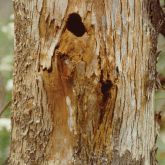Giant wood moth

Female giant wood moth with brown wings and striped brown and white abdomen
© Queensland Government

Tunnel created by larva of giant wood moth revealed in a split log
© NSW DPI

Early signs of giant wood moth attack, showing capped entry hole
© Queensland Government

Giant wood moth exit hole
© DPI NSW

Giant wood moth recently emerged from pupation, with pupal case visible
© Queensland Government

Giant wood moth pupal case emerging from tree stem
© Queensland Government

Staining and tunnelling caused by the giant wood moth
© Queensland Government

Pupae of the giant wood moth
© Queensland Government
The giant wood moth is one of the largest moth species in the world and a traditional food resource to Indigenous Australians. The larvae are also known as witchetty grubs. Giant wood moths affect plantation productivity by weakening trees and increasing the risk of breakage in strong winds.
Scientific name
Similar species
- Endoxyla liturata is another large moth species which is widely distributed in coastal Queensland. It bores into the centre of smooth-barked eucalypts.
Description
- Adults are large, mottled light grey or brownish, with a dark blotch on the thorax. They are rarely seen.
- Females have a wingspan up to 25cm and a relatively large heavy body, up to 30g. Males are generally half the size of females.
- Larvae are large, up to 15cm long and 2–3cm wide, creamy with pink-purple stripes and a red-brown head.
- The first sign of an attack is often a pile of coarse frass (similar to sawdust) at the base of the tree stem and a hole or cover of frass on the trunk.
- Tunnel entrances can be found anywhere from the base to the crown of a tree but are more frequently observed up to 3m high.
- As the larva grows, the stem of the tree swells around the entrance hole.
- Larvae feed singly in J-shaped tunnels in both sapwood and heartwood.
- Before the moths emerge in midsummer, a large, circular exit hole (3–5cm diameter) is created above the smaller entrance hole, which is often plugged with frass.
- Empty pupal cases may protrude from exit holes during summer.
Distribution
- Common along the coast from North to South East Queensland, and also in New South Wales.
- Recorded 200km inland at Theodore, Queensland.
Hosts
Giant wood moths typically attack trees more than 3 years old, and prefer these species:
- Gympie messmate (Eucalyptus cloeziana)
- Dunn's white gum (E. dunnii)
- rose gum (E. grandis and hybrids)
- grey gum (E. longirostrata)
- blackbutt (E. pilularis)
- Sydney blue gum (E. saligna)
- forest red gum (E. tereticornis).
Damage
- Tunnels made by the larvae through the sapwood and heartwood reduce the quality of the timber.
- Smaller trees can snap in strong winds.
- Larger trees are not significantly weakened, although the exit hole may allow the entry of water and fungi. The holes seal within about a year.
- Yellow-tailed black cockatoos tear into stems when feeding on wood moth larvae, further damaging and weakening the tree.
Biology
- Female moths produce thousands of eggs and deposit them in crevices in the bark of living trees.
- Hatchling larvae lower themselves on silken threads and are dispersed by wind. They are believed to spend their early life feeding on roots underground, but this has not been confirmed.
- When larvae are around 25mm long, they bore into the stems or branches of eucalypts, excavating a chamber in the sapwood. The hole is then sealed with a hard plug of compacted sawdust and silk.
- Larvae feed and develop for around 2 years. Their actual food consists of the soft callus tissue which the tree produces in the cambium as it attempts to seal off the invader’s burrow.
- Adult moths emerge throughout summer, typically after heavy rainfall. This life stage is short, as adults have no mouth parts and must survive on fats gained in the larval stage.
Control
- One species of wasp is documented as a parasitoid of E. cinereus, but this has not yet been investigated as a biocontrol agent.
- When establishing hardwood plantations, avoid using species susceptible to the giant wood moth, or avoid growing them in monocultures.
- If infestation has occurred, it may be possible to deter cockatoos by using noise or light disturbance.
Resources and research
- Carnegie, AJ, Lawson, SA, Smith, TE, Pegg, GS, Stone, C, McDonald, JM. 2008. Healthy hardwoods: a field guide to pests, diseases and nutritional disorders in subtropical hardwoods, Forest & Wood Products Australia, Victoria.
- Jones, DL, Elliot, WR, Jones, SR. 2015. Pests, Diseases, Ailments and Allies of Australian Plants. Reed New Holland Publishers Pty Ltd, Chatswood, NSW.
- Peters, BC, King, J, Wylie, FR. 1996. Pests of timber in Queensland. Brisbane: Queensland Forestry Research Institute.
- Thurman, JH. 2022. Beyond the pest: Life history, ecology and ethnoentomology of the giant wood moth (Endoxyla cinereus). Austral Ecology, 47:733–747, viewed 2023.